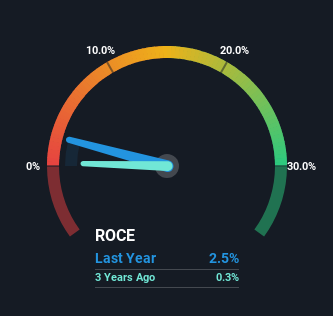Some Investors May Be Worried About Sapporo Holdings' (TSE:2501) Returns On Capital

When researching a stock for investment, what can tell us that the company is in decline? More often than not, we'll see a declining return on capital employed (ROCE) and a declining amount of capital employed. Trends like this ultimately mean the business is reducing its investments and also earning less on what it has invested. In light of that, from a first glance at Sapporo Holdings (TSE:2501), we've spotted some signs that it could be struggling, so let's investigate.
What Is Return On Capital Employed (ROCE)?
For those that aren't sure what ROCE is, it measures the amount of pre-tax profits a company can generate from the capital employed in its business. The formula for this calculation on Sapporo Holdings is:
Return on Capital Employed = Earnings Before Interest and Tax (EBIT) ÷ (Total Assets - Current Liabilities)
0.025 = JP¥12b ÷ (JP¥664b - JP¥191b) (Based on the trailing twelve months to December 2023).
So, Sapporo Holdings has an ROCE of 2.5%. Ultimately, that's a low return and it under-performs the Beverage industry average of 7.1%.
View our latest analysis for Sapporo Holdings

Above you can see how the current ROCE for Sapporo Holdings compares to its prior returns on capital, but there's only so much you can tell from the past. If you're interested, you can view the analysts predictions in our free analyst report for Sapporo Holdings .
So How Is Sapporo Holdings' ROCE Trending?
There is reason to be cautious about Sapporo Holdings, given the returns are trending downwards. Unfortunately the returns on capital have diminished from the 3.5% that they were earning five years ago. On top of that, it's worth noting that the amount of capital employed within the business has remained relatively steady. Since returns are falling and the business has the same amount of assets employed, this can suggest it's a mature business that hasn't had much growth in the last five years. So because these trends aren't typically conducive to creating a multi-bagger, we wouldn't hold our breath on Sapporo Holdings becoming one if things continue as they have.
In Conclusion...
In summary, it's unfortunate that Sapporo Holdings is generating lower returns from the same amount of capital. Since the stock has skyrocketed 191% over the last five years, it looks like investors have high expectations of the stock. In any case, the current underlying trends don't bode well for long term performance so unless they reverse, we'd start looking elsewhere.
Sapporo Holdings does have some risks though, and we've spotted 1 warning sign for Sapporo Holdings that you might be interested in.
For those who like to invest in solid companies, check out this free list of companies with solid balance sheets and high returns on equity.
If you're looking to trade Sapporo Holdings, open an account with the lowest-cost platform trusted by professionals, Interactive Brokers.
With clients in over 200 countries and territories, and access to 160 markets, IBKR lets you trade stocks, options, futures, forex, bonds and funds from a single integrated account.
Enjoy no hidden fees, no account minimums, and FX conversion rates as low as 0.03%, far better than what most brokers offer.
Sponsored ContentNew: Manage All Your Stock Portfolios in One Place
We've created the ultimate portfolio companion for stock investors, and it's free.
• Connect an unlimited number of Portfolios and see your total in one currency
• Be alerted to new Warning Signs or Risks via email or mobile
• Track the Fair Value of your stocks
Have feedback on this article? Concerned about the content? Get in touch with us directly. Alternatively, email editorial-team (at) simplywallst.com.
This article by Simply Wall St is general in nature. We provide commentary based on historical data and analyst forecasts only using an unbiased methodology and our articles are not intended to be financial advice. It does not constitute a recommendation to buy or sell any stock, and does not take account of your objectives, or your financial situation. We aim to bring you long-term focused analysis driven by fundamental data. Note that our analysis may not factor in the latest price-sensitive company announcements or qualitative material. Simply Wall St has no position in any stocks mentioned.
About TSE:2501
Sapporo Holdings
Engages in alcoholic beverages, foods and soft drinks, restaurants, and real estate businesses in Japan and internationally.
Moderate growth potential low.
Similar Companies
Market Insights
Community Narratives




